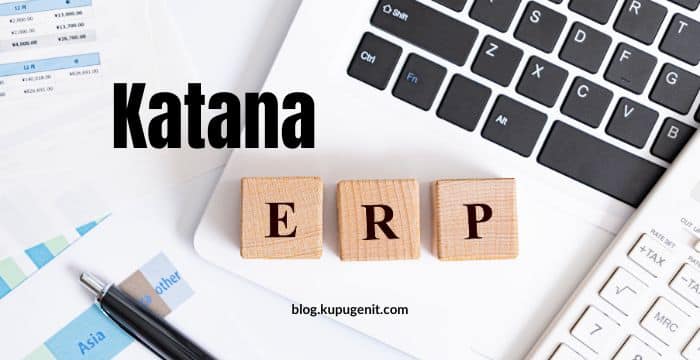blog.kupugenit.com | Katana Erp – Crafting this blog post on Katana ERP has been an exciting journey. Let’s dive into the world of efficient manufacturing and inventory management with Katana.
I. Introduction
In the dynamic landscape of modern business, where efficient manufacturing and streamlined inventory management are paramount, Katana ERP shines as a beacon of excellence. Katana is a comprehensive software solution designed to empower businesses, large and small, with the tools needed to optimize production processes and effortlessly manage their inventory.

II. Key Features and Functionalities of Katana ERP
At the core of Katana ERP are its remarkable features and functionalities. It offers a holistic view of your manufacturing operations and inventory management, allowing you to seamlessly track raw materials, work-in-progress, and finished goods. Katana is also adept at integrating with other essential software, bridging the gap between various aspects of your business, from sales and purchasing to accounting and e-commerce.
III. Benefits of Implementing Katana ERP
The benefits of embracing Katana ERP are manifold. Improved production and inventory control give businesses the ability to meet customer demand efficiently. By reducing waste and optimizing stock levels, Katana leads to substantial cost savings. Its order management and sales tracking capabilities provide a competitive edge, while real-time insights and reporting tools empower data-driven decision-making.
IV. Katana ERP for Different Business Types
Katana ERP isn’t a one-size-fits-all solution. It’s highly adaptable and caters to the unique needs of various business types. Whether you run a small artisanal shop, a bustling e-commerce store, or a complex manufacturing facility, Katana can be tailored to suit your specific requirements.
V. Factors to Consider When Selecting Katana ERP
While Katana ERP offers a plethora of benefits, selecting the right ERP system is crucial. To ensure a successful implementation, businesses need to assess their manufacturing and inventory needs, consider budget constraints, evaluate the user-friendliness of the software, and scrutinize the reputation and support provided by the ERP vendor.
As I delved into the world of Katana, I couldn’t help but appreciate the transformative power it brings to modern businesses. The ability to streamline manufacturing, optimize inventory, and make data-driven decisions is indispensable in today’s competitive landscape. Katana is not just a software; it’s a strategic asset that can propel businesses toward growth and success.
VI. Real-World Success Stories
As I explored the real-world applications of Katana ERP, I was truly inspired by the success stories of businesses that have harnessed its power. One such example is a small artisanal bakery that struggled with inventory management and production planning. Before Katana, they often ran out of key ingredients or overstocked, leading to financial losses. With Katana ERP’s precise inventory tracking and production scheduling, they achieved a perfect balance. This led to reduced wastage, increased customer satisfaction, and remarkable growth in sales.
Another remarkable story is that of an e-commerce fashion brand. They faced the daunting challenge of managing a vast inventory of clothing items with various sizes, colors, and styles. Katana ERP’s user-friendly interface simplified the process of tracking each product variant. The result? Faster order fulfillment, fewer errors, and improved customer reviews. These success stories exemplify how Katana can be a game-changer for businesses, regardless of their size or industry.
VII. Future Trends in Katana ERP
Looking ahead, the future of Katana ERP is undoubtedly promising. Emerging technologies like AI and IoT are poised to enhance its capabilities further. AI-driven predictive analytics will enable businesses to foresee demand patterns and optimize production accordingly, reducing costs and increasing efficiency. Moreover, the Internet of Things will provide real-time data on machinery and inventory, allowing for proactive maintenance and accurate inventory control. The role of Katana in manufacturing and inventory management is evolving into that of a strategic partner, offering insights and solutions that drive sustainable growth.
VIII. Conclusion: Elevating Manufacturing and Inventory Management with Katana ERP
In conclusion, Katana ERP is more than just software; it’s a catalyst for success. Its impact on businesses, from small bakeries to large e-commerce brands, is transformative. By optimizing manufacturing, streamlining inventory management, and providing real-time insights, Katana equips businesses to thrive in today’s competitive landscape. It’s an indispensable tool that empowers businesses to elevate their operations and achieve new heights of efficiency and profitability.
IX. FAQs about Katana ERP
Q: Is Katana suitable for small businesses?
A: Absolutely. Katana is designed to cater to businesses of all sizes, including small and medium-sized enterprises (SMEs). Its scalability makes it an ideal choice for businesses looking to grow.
Q: How does Katana handle inventory tracking?
A: Katana offers robust inventory tracking capabilities. It provides real-time insights into stock levels, order statuses, and more, ensuring businesses have full control over their inventory.
Q: Can Katana integrate with other software?
A: Yes, Katana is known for its integration capabilities. It can seamlessly connect with e-commerce platforms, accounting software, and other essential tools, making it a versatile solution for businesses.
Q: What kind of support does Katana ERP offer?
A: Katana provides customer support to assist with any inquiries or issues. They offer resources like tutorials and documentation to help users make the most of the software.
As I wrap up this exploration of Katana ERP, I can’t help but emphasize its potential to transform businesses and position them for a successful future. It’s not just about managing inventory or production; it’s about reshaping the way businesses operate and ensuring they are well-prepared for whatever challenges and opportunities lie ahead.